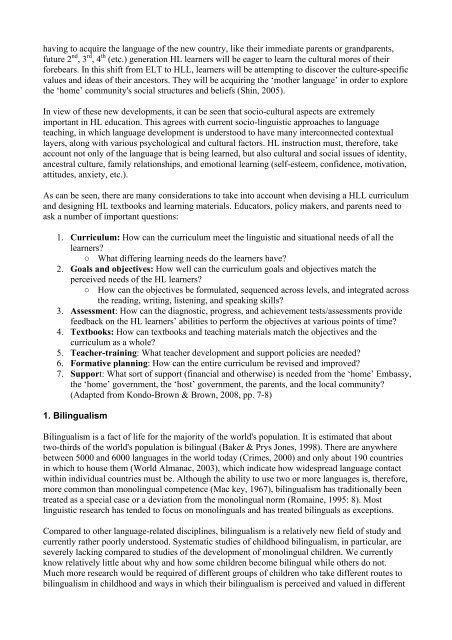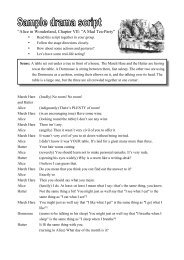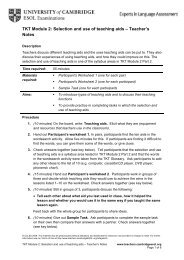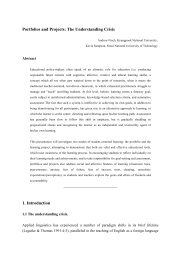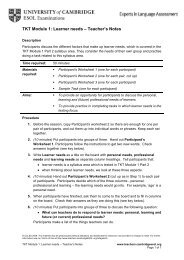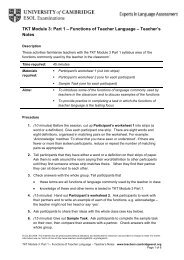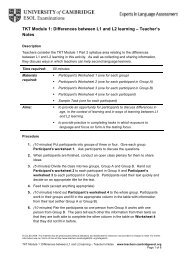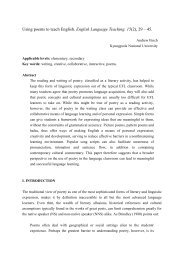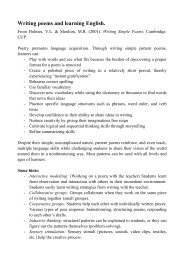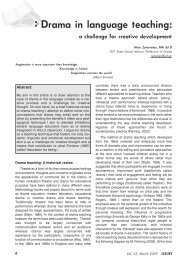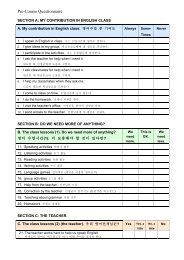here - Finchpark
here - Finchpark
here - Finchpark
You also want an ePaper? Increase the reach of your titles
YUMPU automatically turns print PDFs into web optimized ePapers that Google loves.
having to acquire the language of the new country, like their immediate parents or grandparents,future 2 nd , 3 rd , 4 th (etc.) generation HL learners will be eager to learn the cultural mores of theirforebears. In this shift from ELT to HLL, learners will be attempting to discover the culture-specificvalues and ideas of their ancestors. They will be acquiring the ‘mother language’ in order to explorethe ‘home’ community's social structures and beliefs (Shin, 2005).In view of these new developments, it can be seen that socio-cultural aspects are extremelyimportant in HL education. This agrees with current socio-linguistic approaches to languageteaching, in which language development is understood to have many interconnected contextuallayers, along with various psychological and cultural factors. HL instruction must, t<strong>here</strong>fore, takeaccount not only of the language that is being learned, but also cultural and social issues of identity,ancestral culture, family relationships, and emotional learning (self-esteem, confidence, motivation,attitudes, anxiety, etc.).As can be seen, t<strong>here</strong> are many considerations to take into account when devising a HLL curriculumand designing HL textbooks and learning materials. Educators, policy makers, and parents need toask a number of important questions:1. Curriculum: How can the curriculum meet the linguistic and situational needs of all thelearners?○ What differing learning needs do the learners have?2. Goals and objectives: How well can the curriculum goals and objectives match theperceived needs of the HL learners?○ How can the objectives be formulated, sequenced across levels, and integrated acrossthe reading, writing, listening, and speaking skills?3. Assessment: How can the diagnostic, progress, and achievement tests/assessments providefeedback on the HL learners’ abilities to perform the objectives at various points of time?4. Textbooks: How can textbooks and teaching materials match the objectives and thecurriculum as a whole?5. Teacher-training: What teacher development and support policies are needed?6. Formative planning: How can the entire curriculum be revised and improved?7. Support: What sort of support (financial and otherwise) is needed from the ‘home’ Embassy,the ‘home’ government, the ‘host’ government, the parents, and the local community?(Adapted from Kondo-Brown & Brown, 2008, pp. 7-8)1. BilingualismBilingualism is a fact of life for the majority of the world's population. It is estimated that abouttwo-thirds of the world's population is bilingual (Baker & Prys Jones, 1998). T<strong>here</strong> are anyw<strong>here</strong>between 5000 and 6000 languages in the world today (Crimes, 2000) and only about 190 countriesin which to house them (World Almanac, 2003), which indicate how widespread language contactwithin individual countries must be. Although the ability to use two or more languages is, t<strong>here</strong>fore,more common than monolingual competence (Mac key, 1967), bilingualism has traditionally beentreated as a special case or a deviation from the monolingual norm (Romaine, 1995: 8). Mostlinguistic research has tended to focus on monolinguals and has treated bilinguals as exceptions.Compared to other language-related disciplines, bilingualism is a relatively new field of study andcurrently rather poorly understood. Systematic studies of childhood bilingualism, in particular, areseverely lacking compared to studies of the development of monolingual children. We currentlyknow relatively little about why and how some children become bilingual while others do not.Much more research would be required of different groups of children who take different routes tobilingualism in childhood and ways in which their bilingualism is perceived and valued in different


